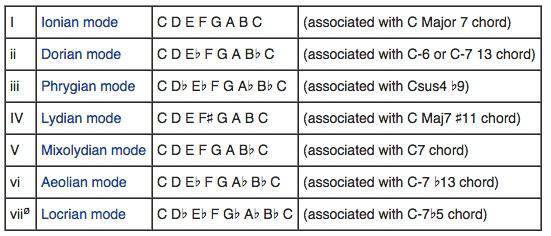
Medieval Mode Music Theory
Share
Medieval Mode, also known as Church Mode. Derived from ancient Greek music modes. The early Medieval church modes proposed by the ancient Roman theologian Boethius had eight modes: four normal modes and four sub modes. The range of the sub mode is five degrees lower than that of the normal mode. The musical scale in the Middle Ages is arranged from bottom to top, with four ending notes of Dorian, Phrygian, Lydian, and Mixolydian.
Fixed tone:
- Ionian mode (equivalent to natural major, for example: C Ionian scale is C natural major scale.)
- Dorian mode (Natural minor nature, raising the sixth grade in the scale.)
- Phrygian mode (Natural minor, lowering the second level of the scale.)
- Lydian mode (raise the fourth grade in the scale.)
- Mixolydian mode (the nature of natural major, reducing the VI level in the scale.)
- Aeolian mode (equivalent to natural minor, for example: a Ionian mode is a natural minor.)
- Locrian mode (natural minor, lowering the second and V levels in the scale.)

Movable tone:
- The mode with the first tune do as the main tone is called the Ionian mode.
- The mode with the first tune called re as the main tone is called Dorian mode.
- The mode with the first tune of solo mi as the main tone is called Phrygian mode.
- The mode with the first tune fa as the main tone is called Lydian mode.
- The mode with the first tune sol as the main tone is called Mixolydian.
- The mode with the first tune called la as the main tone is called Aeolian mode.
- The mode with the first tune si as the main tone is called Locrian mode.

These seven modes can also be memorized in a semitone relationship:
Ionian:whole-whole-half-whole-whole-whole-half
Dorian:whole-half-whole-whole-whole-half-whole
Phrygian:half-whole-whole-whole-half-whole-whole
Lydian:whole-whole-whole-half-whole-whole-half
Mixolydian:whole-whole-half-whole-whole-half-whole
Aeolian:whole-half-whole-whole-half-whole-whole
Locrian:half-whole-whole-half-whole-whole-whole
How to use the different modes
Let us take a 7th chord as an example. For example, the Cmaj7 chord, its constituent sound is CEGB, then these 4 notes are the vowel notes in music with Cmaj7 as the harmony, and the remaining notes can be regarded as consonant notes. Cmaj7=1 3 5 7=CEGB, how to get these four notes can be obtained according to the formula: tonic + major third + minor third + major third.
What modes can be used in Cmaj7 chords? The basic principle is that the mode used must contain vowel note. Then we can get:
- CIonian mode (C major scale) = (fixed key) 1 2 3 4 5 6 7 = (primary mode) C D E F G A B
- C Lydian mode = (fixed mode) 1 2 3 #4 5 6 7= (first mode) C D E #F G A B
Then we look at the Dmin7 chord, Dm7=1 b3 5 b7=D F A C (tonic + minor third + major third + minor third)
The modes are:
- D Dorian mode = (fixed mode) 1 2 b3 4 5 6 b7 = (movable mode) D E F G A B C
- D Phrygian mode = (fixed mode) 1 b2 b3 4 5 b6 b7 = (movable mode) D Eb F G A Bb C
- D Aeolian mode (D minor scale) = (fixed key) 1 2 b3 4 5 b6 b7 = (primary key) D E F G A Bb C
The last is a 7th chord, G7, G7=1 3 5 b7=G B D F (tonic + major third + minor third + minor third)
G Mixolydia mode = (fixed mode) 1 2 3 4 5 6 b7 = movable mode G A B C D E F
In the basic mode, we can have more choices, if we add other mode scales, such as diatonic scale, pentatonic scale, BLUES scale, various arpeggios, intervals, etc. The options available can be very wide.
